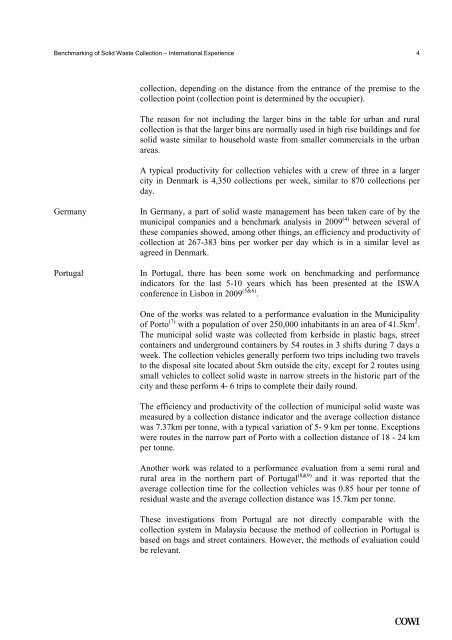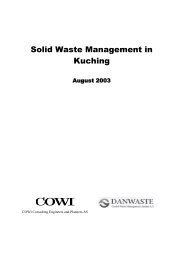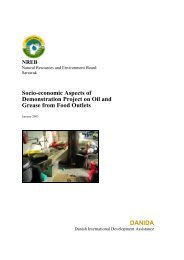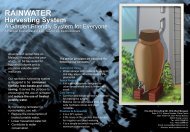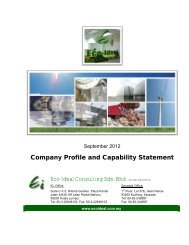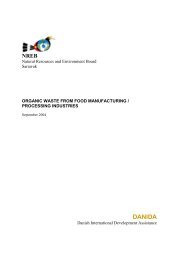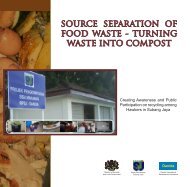Proposal for benchmarking on efficiency and produc-tivity
Proposal for benchmarking on efficiency and produc-tivity
Proposal for benchmarking on efficiency and produc-tivity
You also want an ePaper? Increase the reach of your titles
YUMPU automatically turns print PDFs into web optimized ePapers that Google loves.
Benchmarking of Solid Waste Collecti<strong>on</strong> – Internati<strong>on</strong>al Experience 4<br />
collecti<strong>on</strong>, depending <strong>on</strong> the distance from the entrance of the premise to the<br />
collecti<strong>on</strong> point (collecti<strong>on</strong> point is determined by the occupier).<br />
The reas<strong>on</strong> <str<strong>on</strong>g>for</str<strong>on</strong>g> not including the larger bins in the table <str<strong>on</strong>g>for</str<strong>on</strong>g> urban <strong>and</strong> rural<br />
collecti<strong>on</strong> is that the larger bins are normally used in high rise buildings <strong>and</strong> <str<strong>on</strong>g>for</str<strong>on</strong>g><br />
solid waste similar to household waste from smaller commercials in the urban<br />
areas.<br />
A typical <strong>produc</strong><strong>tivity</strong> <str<strong>on</strong>g>for</str<strong>on</strong>g> collecti<strong>on</strong> vehicles with a crew of three in a larger<br />
city in Denmark is 4,350 collecti<strong>on</strong>s per week, similar to 870 collecti<strong>on</strong>s per<br />
day.<br />
Germany<br />
Portugal<br />
In Germany, a part of solid waste management has been taken care of by the<br />
municipal companies <strong>and</strong> a benchmark analysis in 2009 (4) between several of<br />
these companies showed, am<strong>on</strong>g other things, an <strong>efficiency</strong> <strong>and</strong> <strong>produc</strong><strong>tivity</strong> of<br />
collecti<strong>on</strong> at 267-383 bins per worker per day which is in a similar level as<br />
agreed in Denmark.<br />
In Portugal, there has been some work <strong>on</strong> <str<strong>on</strong>g>benchmarking</str<strong>on</strong>g> <strong>and</strong> per<str<strong>on</strong>g>for</str<strong>on</strong>g>mance<br />
indicators <str<strong>on</strong>g>for</str<strong>on</strong>g> the last 5-10 years which has been presented at the ISWA<br />
c<strong>on</strong>ference in Lisb<strong>on</strong> in 2009 (5&6) .<br />
One of the works was related to a per<str<strong>on</strong>g>for</str<strong>on</strong>g>mance evaluati<strong>on</strong> in the Municipality<br />
of Porto (7) with a populati<strong>on</strong> of over 250,000 inhabitants in an area of 41.5km 2 .<br />
The municipal solid waste was collected from kerbside in plastic bags, street<br />
c<strong>on</strong>tainers <strong>and</strong> underground c<strong>on</strong>tainers by 54 routes in 3 shifts during 7 days a<br />
week. The collecti<strong>on</strong> vehicles generally per<str<strong>on</strong>g>for</str<strong>on</strong>g>m two trips including two travels<br />
to the disposal site located about 5km outside the city, except <str<strong>on</strong>g>for</str<strong>on</strong>g> 2 routes using<br />
small vehicles to collect solid waste in narrow streets in the historic part of the<br />
city <strong>and</strong> these per<str<strong>on</strong>g>for</str<strong>on</strong>g>m 4- 6 trips to complete their daily round.<br />
The <strong>efficiency</strong> <strong>and</strong> <strong>produc</strong><strong>tivity</strong> of the collecti<strong>on</strong> of municipal solid waste was<br />
measured by a collecti<strong>on</strong> distance indicator <strong>and</strong> the average collecti<strong>on</strong> distance<br />
was 7.37km per t<strong>on</strong>ne, with a typical variati<strong>on</strong> of 5- 9 km per t<strong>on</strong>ne. Excepti<strong>on</strong>s<br />
were routes in the narrow part of Porto with a collecti<strong>on</strong> distance of 18 - 24 km<br />
per t<strong>on</strong>ne.<br />
Another work was related to a per<str<strong>on</strong>g>for</str<strong>on</strong>g>mance evaluati<strong>on</strong> from a semi rural <strong>and</strong><br />
rural area in the northern part of Portugal (8&9) <strong>and</strong> it was reported that the<br />
average collecti<strong>on</strong> time <str<strong>on</strong>g>for</str<strong>on</strong>g> the collecti<strong>on</strong> vehicles was 0.85 hour per t<strong>on</strong>ne of<br />
residual waste <strong>and</strong> the average collecti<strong>on</strong> distance was 15.7km per t<strong>on</strong>ne.<br />
These investigati<strong>on</strong>s from Portugal are not directly comparable with the<br />
collecti<strong>on</strong> system in Malaysia because the method of collecti<strong>on</strong> in Portugal is<br />
based <strong>on</strong> bags <strong>and</strong> street c<strong>on</strong>tainers. However, the methods of evaluati<strong>on</strong> could<br />
be relevant.<br />
.


